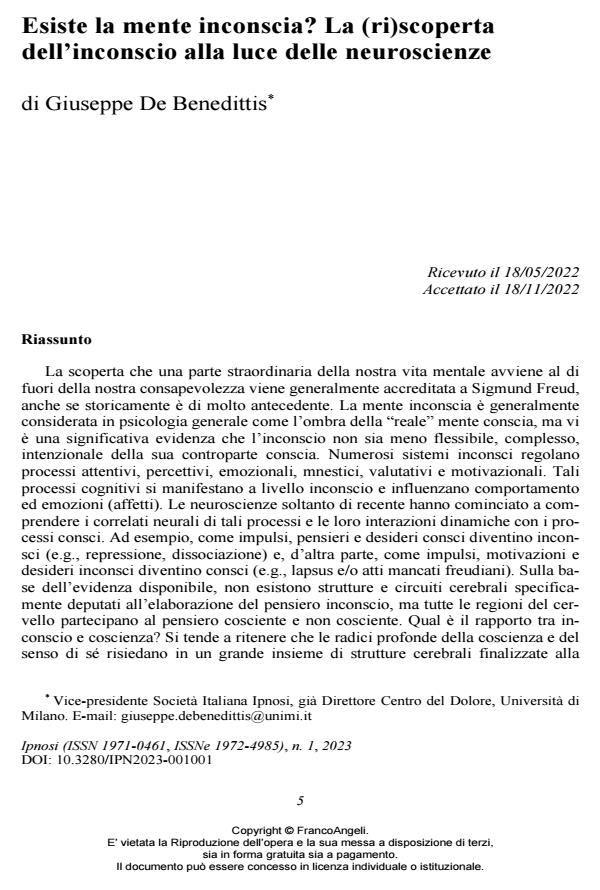The (Re) Discovery of the Unconscious. What we have learned from neuroscience
Journal title IPNOSI
Author/s Giuseppe De Benedittis
Publishing Year 2023 Issue 2023/1
Language Italian Pages 18 P. 5-22 File size 388 KB
DOI 10.3280/IPN2023-001001
DOI is like a bar code for intellectual property: to have more infomation
click here
Below, you can see the article first page
If you want to buy this article in PDF format, you can do it, following the instructions to buy download credits

FrancoAngeli is member of Publishers International Linking Association, Inc (PILA), a not-for-profit association which run the CrossRef service enabling links to and from online scholarly content.
The discovery that an extraordinary part of our mental life takes place outside our awareness is generally credited to Sigmund Freud, even if historically it goes back a long way. The unconscious mind is generally considered in general psy-chology as the shadow of the “real” conscious mind, but there is significant evi-dence that the unconscious is no less flexible, complex, and intentional than its conscious counterpart. Numerous unconscious systems regulate attentional, per-ceptual, emotional, mnestic, evaluative and motivational processes. These cogni-tive processes occur unconsciously and influence behavior and emotions (affects). Neuroscience has only recently begun to understand the neural correlates of such processes and their dynamic interactions with conscious processes. For example, how conscious impulses, thoughts and desires become unconscious (e.g., repres-sion, dissociation) and, on the other hand, how unconscious impulses, motivations and de-sires become conscious (e.g., Freudian slip and / or failed acts). There are no brain structures and circuits specifically dedicated to the processing of uncon-scious thought, but all brain regions participate in conscious and non-conscious thought. But what is the relationship between the unconscious and consciousness? We tend to believe that the deep roots of consciousness and the sense of self re-side in a large set of brain structures aimed at neural mapping of the body and homeostasis in an unconscious way. This would be the “Proto-Self” Unconscious (Damasio, 2003), from which the conscious experience would emerge. In this per-spective, it can be argued that the actions of the unconscious mind precede and influence the emergence of the conscious mind. We do not know if these implicit and automatic activities can be conceptualized and organized in a self-conscious mind to resemble the self-conscious mind. Although perceptions, feelings, motiva-tions and some decision-making processes may occur outside of awareness, what seems to be lacking is the ability and intensity of these implicit activities to self-organize, possibly through a bottom-up mechanism of neural coalitions, in a co-herent, meaningful and targeted representation of reality.
Keywords: unconscious, neural mechanisms, consciousness, relationship con-scious-unconscious mind.
Giuseppe De Benedittis, Esiste la mente inconscia? La (ri)scoperta dell’inconscio alla luce delle neuroscienze in "IPNOSI" 1/2023, pp 5-22, DOI: 10.3280/IPN2023-001001